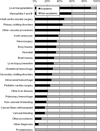Off-label use of recombinant factor VIIa in U.S. hospitals: analysis of hospital records
- PMID: 21502649
- PMCID: PMC4011398
- DOI: 10.7326/0003-4819-154-8-201104190-00002
Off-label use of recombinant factor VIIa in U.S. hospitals: analysis of hospital records
Abstract
Background: Recombinant factor VIIa (rFVIIa) is approved for treatment of bleeding in patients who have hemophilia with inhibitors but has been applied to a wide range of off-label indications.
Objective: To estimate patterns of off-label rFVIIa use in U.S. hospitals.
Design: Retrospective database analysis.
Setting: Data were extracted from the Premier Perspectives database (Premier, Charlotte, North Carolina), which contains discharge records from a sample of academic and nonacademic U.S. hospitals.
Patients: 12 644 hospitalizations for patients who received rFVIIa during a hospital stay.
Measurements: Hospital diagnoses and patient dispositions from 1 January 2000 to 31 December 2008. Statistical weights for each hospital were used to provide national estimates of rFVIIa use.
Results: From 2000 to 2008, off-label use of rFVIIa in hospitals increased more than 140-fold, such that in 2008, 97% (95% CI, 96% to 98%) of 18 311 in-hospital uses were off-label. In contrast, in-hospital use for hemophilia increased less than 4-fold and accounted for 2.7% (CI, 1.9% to 3.5%) of use in 2008. Adult and pediatric cardiovascular surgery (29% [CI, 21% to 33%]), body and brain trauma (29% [CI, 19% to 38%]), and intracranial hemorrhage (11% [CI, 7.7% to 14%]) were the most common indications for rFVIIa use. Across all indications, in-hospital mortality was 27% (CI, 19% to 34%) and 43% (CI, 26% to 59%) of patients were discharged to home.
Limitation: Accuracy and completeness of the discharge diagnoses and patient medication records in the database sample cannot be verified.
Conclusion: Off-label use of rFVIIa in the hospital setting far exceeds use for approved indications. These patterns raise concern about the application of rFVIIa to conditions for which strong supporting evidence is lacking.
Figures



Comment in
-
A hemorrhage of off-label use.Ann Intern Med. 2011 Apr 19;154(8):566-7. doi: 10.7326/0003-4819-154-8-201104190-00010. Ann Intern Med. 2011. PMID: 21502655 No abstract available.
-
Off-label use of recombinant factor VIIa.Ann Intern Med. 2011 Sep 6;155(5):337-8; author reply 338-9. doi: 10.7326/0003-4819-155-5-201109060-00021. Ann Intern Med. 2011. PMID: 21893632 No abstract available.
-
Off-label use of recombinant factor VIIa.Ann Intern Med. 2011 Sep 6;155(5):337; author reply 338-9. doi: 10.7326/0003-4819-155-5-201109060-00020. Ann Intern Med. 2011. PMID: 21893633 No abstract available.
References
-
- Stafford RS. Regulating off-label drug use—rethinking the role of the FDA. N Engl J Med. 2008;358:1427–1429. - PubMed
-
- Hedner U. Factor VIIa and its potential therapeutic use in bleeding-associated pathologies. Thromb Haemost. 2008;100:557–562. - PubMed
-
- Roberts HR, Monroe DM, White GC. The use of recombinant factor VIIa in the treatment of bleeding disorders. Blood. 2004;104:3858–3864. - PubMed
-
- Roberts HR, Monroe DM, Hoffman M. Safety profile of recombinant factor VIIa. Semin Hematol. 2004;41:101–108. - PubMed
-
- Thomas GO, Dutton RP, Hemlock B, Stein DM, Hyder M, Shere-Wolfe R, Hess JR, Scalea TM. Thromboembolic complications associated with factor VIIa administration. J Trauma. 2007;62:564–569. - PubMed
Publication types
MeSH terms
Substances
Grants and funding
LinkOut - more resources
Full Text Sources
Other Literature Sources
Medical
